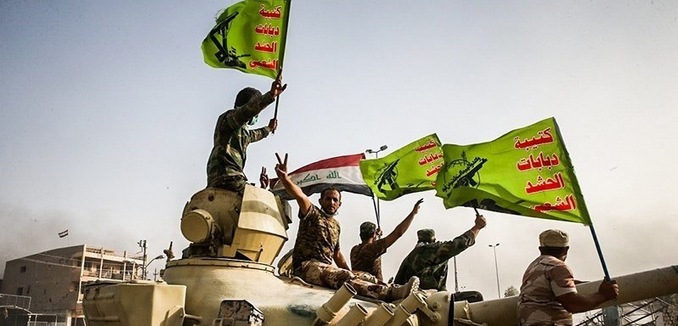On Sunday, one of the Middle East’s most feared operators traveled to northern Iraq. Qassem Soleimani, the commander of the elite Quds force—the foreign wing of the Iranian Revolutionary Guards Corps—was on a mission: to destroy the Kurdish dream of independence.
Things began to unravel quickly. In the early hours of Monday morning, I was woken up by a call from the frontline in Kirkuk. “We are under fire,” my source said. “They are shooting at our troops.”
My source was a Peshmerga, a soldier fighting with the army of the autonomous Kurdish region in northern Iraq. With “they” he meant the Iranian Quds-backed Iraqi armed forces and the Shiite umbrella militia Hashd al-Shaabi.
The two factions advanced on Kurdish controlled areas from several fronts, using advanced weapons supplied to them by coalition partners in the fight against Isil, including United States Abrams tanks and Humvees, with the intent to gain control of Kirkuk’s strategic oilfields and the K1 military base.
The previous day, Soleimani had met in Sulaimaniya with the leaders of the Patriotic Union of Kurdistan, or P.U.K., one of the two main Kurdish political parties led by the relatives of the late Jalal Talabani, the first (and only) Kurdish president of Iraq.
It is unknown what message the notorious enforcer of the clerical regime in Tehran carried. But within hours of meeting with Soleimani, P.U.K. troops withdrew from their positions in and around Kirkuk and gave way to invading forces. The Kurdistan Democratic Party, or K.D.P, the ruling party of KRG President Masoud Barzani, called it a betrayal of epic proportions.
On a regional scale, the attack on Kirkuk, ordered by Iraqi Prime Minister Haider al-Abadi with the blessing of the mullahs in Tehran, was a punitive measure against the KRG for the independence referendum which took place last month. A vast majority, 92.7% of the autonomous region’s population voted in favor of breaking away from Iraq in September.
But the crisis in Kirkuk has a dimension to it which far exceeds the political conflict between the KRG in Erbil and the central government in Baghdad. There is no such thing as coincidence in the Middle East. And it was certainly no coincidence that Iranian-backed militia advanced on a key U.S. ally just days after the Trump administration announced it was not recertifying the nuclear accord with the Islamic Republic and designated the IRGC as a terrorist organisation in its entirety.
On Friday, President Donald Trump announced a new strategy to confront what he called “the Iranian regime’s hostile actions” in the region, citing Tehran’s involvement in the “sectarian violence in Iraq, and vicious civil wars in Yemen and Syria.” Two days later, Qassem Soleimani put Trump’s words to the test, using Kurdish forces as war bait. And Washington failed the test.
The U.S. government released a statement on Monday, saying it was not taking sides in the conflict. “Coalition forces and advisors are not supporting Government of Iraq or Kurdistan Regional Government activities near Kirkuk, but are aware of reports of a limited exchange of fire during predawn hours of darkness Oct. 16,” it stated.
Iran was not mentioned in the statement, although Tehran’s hand in the offensive in Kirkuk was impossible to miss. Iranian-backed militia groups, such as the Badr Brigade, Asa’ib Ahl al-Haq, Kata’ib Hezbollah, Abbas Division, Ali Akbar, Khorasan and Imam Ali, were all taking part in the attack, while senior Iranian commanders, including Soleimani, as well as Iraqis closely aligned with Tehran, Qais Khazali, Hadi Al-Ameri and Abu Mahdi al-Muhandis, were on the ground supervising the assault.
Most of these groups have a dark past and are led by individuals with a long history of aggression against the West. Qais Khazali, the leader of the militia group Asa’ib Ahl al-Haq, was the mastermind behind the kidnapping and killing of four American soldiers in Karbala in 2007. The commander of Kata’ib Hezbollah, Jamal Jaafar Ibrahimi, widely known by his nom de guerre Abu Mahdi al-Mohandis, was convicted for the American Embassy bombing in Kuwait in 1983 and is a designated terrorist by the U.S. government.
The same men looked on as their soldiers lowered the Kurdish flag at Kirkuk’s provincial council and replaced it with an Iraqi flag on Monday. Peshmerga troops had defended Kirkuk three years ago, when the Iraqi army abandoned their U.S.-supplied weapons and fled when Isil marched on the city.
Since the assault on Kirkuk, Kurdish forces have lost around 40% of KRG-controlled territory, including Sinjar and Bashiqa, shrinking Kurdish land to its 2003 borders. It is a devastating setback for the Kurdish regional government in their quest for independence. It is also a victory for Iran over the U.S. A high-ranking KRG official told me that the assault was part of “an Iranian plot to complete its regional hegemony.”
“Kurdistan”, he said, “remains a bulwark against Iran and religious extremism. America must choose between Iran and Kurdistan.”
[Photo: Tasnim News Agency / WikiCommons ]




